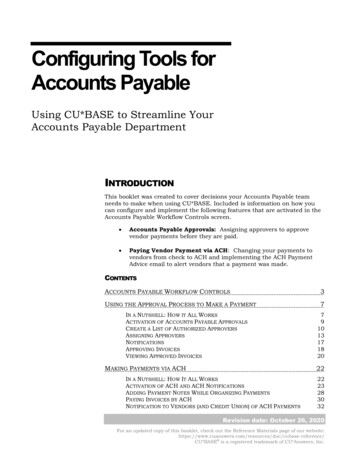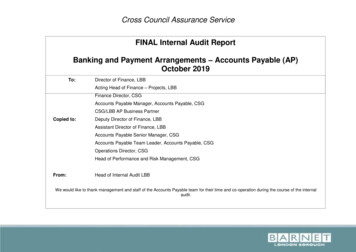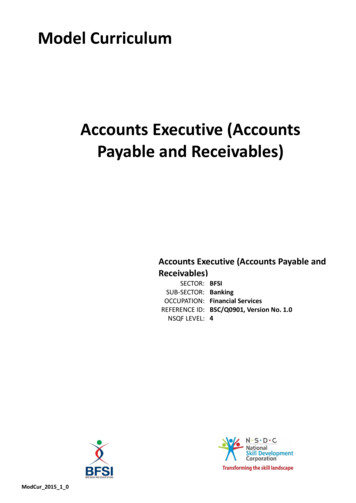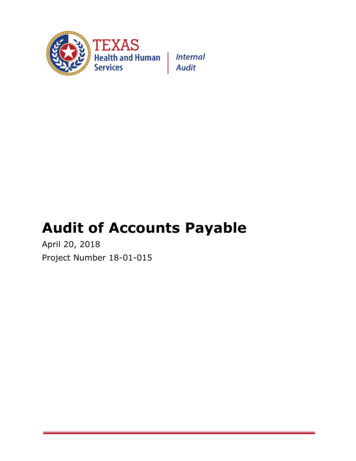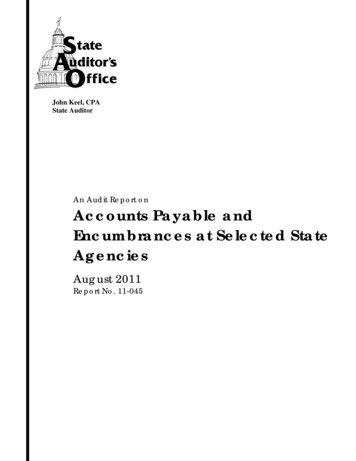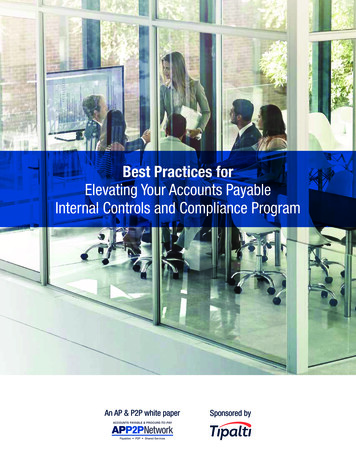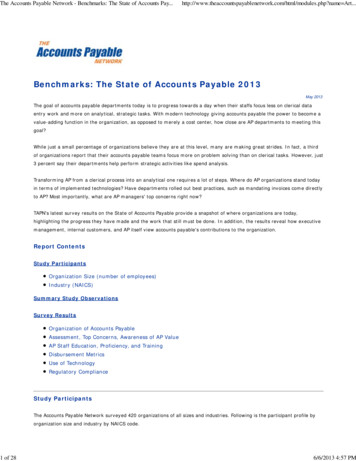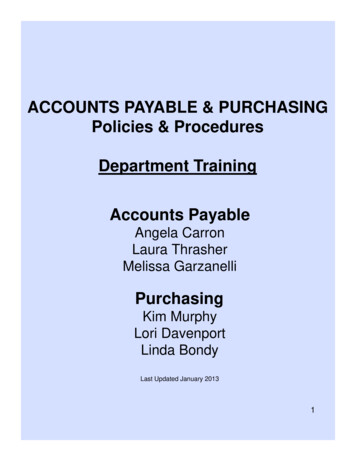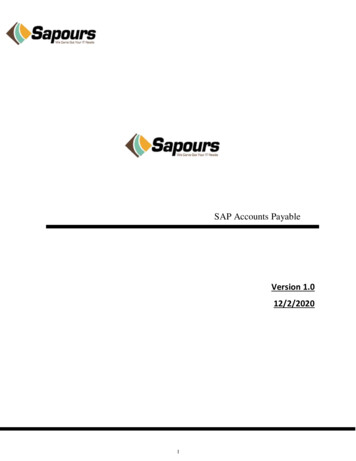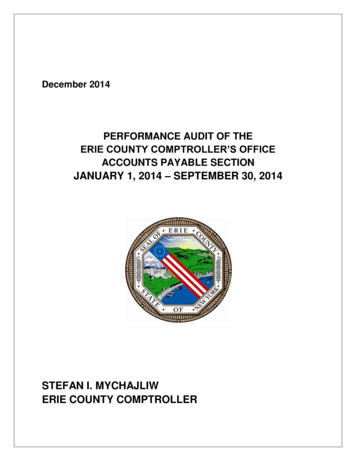
Transcription
December 2014PERFORMANCE AUDIT OF THEERIE COUNTY COMPTROLLER’S OFFICEACCOUNTS PAYABLE SECTIONJANUARY 1, 2014 – SEPTEMBER 30, 2014STEFAN I. MYCHAJLIWERIE COUNTY COMPTROLLER
HON. STEFAN I. MYCHAJLIWERIE COUNTY COMPTROLLER’S OFFICEDIVISION OF AUDIT & CONTROL95 FRANKLIN STREETBUFFALO, NEW YORK 14202December 31, 2014Erie County Legislature92 Franklin Street 4th FloorBuffalo, New York 14202Dear Honorable Members:The Erie County Comptroller’s Office has completed a performance audit of the AccountsPayable section of the Comptroller’s Office for the period January 1, 2014 to September 30,2014.We conducted our audit in accordance with Generally Accepted Government AuditingStandards. Those standards require that we plan and perform the audit to obtain sufficient,appropriate evidence to provide a reasonable basis for our findings and conclusions. Ourobjectives were to (1) ensure that internal controls are in place to prevent or detectunauthorized, unwarranted or fraudulent payments; (2) ensure that invoices are properlyrecorded to the extent that Accounts Payable is responsible for review of invoices; (3) ensurethat the review and payment of invoices are in compliance with established policies andprocedures; and (4) ensure that payments are appropriately and timely processed. We believethe evidence obtained provides a reasonable basis for our findings and conclusions based onour audit objectives.In our opinion internal controls within the Erie County Comptroller’s Accounts Payable sectionover the processing and payment of invoices are adequate.2
Table of ContentsBACKGROUND . 4FINDINGS. 5I. Current Practices Do Not Agree With Published Online Policies . 5II. Standard Practice is Not a Written Policy . 6AUDITOR’S COMMENTS . 7I. Payment Backup is Not Always Available . 7II. Recurring Batches are Processed with a Negative Confirmation . 7III. Vendor Statements are Not Reconciled . 7RESULTS OF EXIT CONFERENCE . 83
BACKGROUNDAccounts Payable (A/P) is a section of the Erie County Comptroller’s Office. This sectionprocesses accounts payable invoices and payments. The types of invoices processed fall intofour categories: payments covered under contracts, blanket purchase orders, payments forpurchase orders, and direct payments requiring an authorized signature. Invoices are paid on aweekly basis via printed check or electronic payment. In addition, the Board of Elections, theDepartment of Senior Services (RSVP Program), the Department of Social Services (AdultProtection Program), and the Probation Department send electronic invoice batches which areprocessed and imported into SAP. Printed checks for payment of these invoices are returned tothe department for processing.A/P consists of four full time employees who perform the majority of accounts payableprocessing. An employee outside of A/P handles recurring rental invoices and Board ofElections batches. A/P processes accounts payable transactions through payment. Generalledger and reporting functions are handled outside of the department by other Erie CountyComptroller’s office personnel. A/P is an internal division of the Comptroller’s Office; as suchother Comptroller’s Office personnel are familiar with the processes and may occasionally assistA/P if necessary.4
FINDINGSI. Current Practices Do Not Agree With Published Online PoliciesOnline Accounting Policies (Policies) are posted on the County of Erie SharePoint website to“provide definitive and authoritative accounting and financial reporting guidance for the Countyof Erie”. The Accounts Payable section of the Policies states that it “provides the guidelines tobe followed when processing payments through the Comptroller’s Office”.The Accounts Payable Overview section of the Policies states that “either the vendor’s originalinvoice or a copy of an original invoice (must be certified by an individual with payment authorityaccompanied by the endorsement “USE IN LIEU OF ORIGINAL”) is submitted to theComptroller’s Office for payment.” Current standard practice in A/P does not require receipt ofthe original or a copy stamped “USE IN LIEU OF ORIGINAL”. Industry-wide accountingprocedures generally require the use of original invoices or stamped copies to help avoidduplicate charges. Other standard procedures in use by A/P to accomplish this objective includea standard practice of entering all leading zeros in an invoice number, active approvals of directpay invoices, or matching with purchase orders, goods receipts, or contracts and budgetaryrestraints.The Accounts Payable Overview section further states that “the County’s policy is to not utilizerecurring payment transactions (i.e., transactions of fixed amounts occurring at regular intervalsover a specific period of time)”. Current practice in A/P includes the use of a recurring batch forrental payments based on a spreadsheet created at the beginning of the year and adjusted asrental agreements are updated.The Comptroller’s County Travel Policy and Prescription (CAP 210-1) states that the use ofpersonal vehicles for County travel is restricted to such cases where it is to the advantage of theCounty. In such cases mileage will be reimbursed at the Internal Revenue Service establishedallowance rate. The current practice in A/P allows for reimbursement of mileage or gas receipts.Additionally the current reimbursement form does not denote whether a county or personalvehicle was used, which would allow for gas reimbursement but not mileage.WE RECOMMEND that either A/P require originals or properly stamped copies or that theonline policy be revised to reflect standard practice.WE FURTHER RECOMMEND that either A/P requires individual invoices for each rentalpayment or that the online policy be amended for this exception.WE FURTHER RECOMMEND that the online policy be amended to reflect the acceptance ofgas receipts for use of a personal vehicle and that the travel reimbursement form be redesignedto include determination of personal vehicle or county vehicle.5
II. Standard Practice is Not a Written PolicyA/P has a standard practice of entering all leading zeros as part of the invoice number. Theconsistent application of this policy helps to prevent duplicate invoice numbers being entered forthe same vendor. This standard practice has not been formally written and included in theofficial “invoice processing instructions”.WE RECOMMEND that the “invoice processing instructions” be updated to reflect the standardpractice of entering all leading zeros.6
AUDITOR’S COMMENTSI. Payment Backup is Not Always AvailableOf the 120 checks statistically selected for testing, we could not locate 2 of the items forverification. Paper copies of check remittances and backup are stored in unlocked file cabinetsin the accounting office and pulled from the files whenever necessary. It is possible for theseitems to be lost or misfiled, making the paper backup unavailable. In both instances there is arecord of the invoices and payment in the computer system.WE RECOMMEND that A/P research the possibility of scanning all backup into a computerdocument. This would prevent loss or misfiling of documentation. Research should includeconsideration of the cost involved to purchase or adapt adequate software and computerstorage as well as the time required of personnel vs. the availability of the paper backup inaddition to SAP stored invoice and payment information.II. Recurring Batches are Processed with a Negative ConfirmationRent payments are processed on a monthly basis from a spreadsheet generated at thebeginning of the year and updated when leases or rental agreements are expired or renewed, orwhen new leases are signed. A negative confirmation is sent out each month and if no responseis received the monthly payments are made.WE RECOMMEND that a positive confirmation be sent out each month requiring a responsefrom the person authorized to sign for the rental. This would help to prevent automatic paymentsthat have not been reviewed on a monthly basis.III. Vendor Statements are Not ReconciledDue to the limited availability of personnel hours, the current A/P practice regarding vendorstatements is to perform a quick review for any noticeably past due invoices. This practice doesnot work adequately for vendors who only carry forward prior balances without listing theoutstanding invoices.WE RECOMMEND that all vendor statements be reconciled when received to the extentpossible with available personnel hours. Priority should be given to statements showingnoticeably past due items and statements with unidentified carry forward balances.7
RESULTS OF EXIT CONFERENCEAn exit conference was held on December 30, 2014 with the Deputy Comptroller andSupervising Data Processing Control Clerk. The contents of the report were discussed and A/Pwas in general agreement with our findings, auditor’s comments and recommendations.A/P noted at the exit conference that the usage of recurring batches was initially started inresponse to non-receipt of invoices from vendors for lease and rental payments. We wereinformed that positive confirmations are now being sent for these recurring batches.We were further informed that outdated policies on the Sharepoint website will be updated.In accordance with the County’s Audit Response System and Procedures, we request that A/Pprepare a written response to the Director of Budget and Management and the CountyExecutive concerning the findings and recommendations by January 29, 2015. We furtherrequest that the County Executive forward copies of the written response to the Comptroller’sOffice, the Erie County Legislature and the Erie County Fiscal Stability Authority by February 13,2015.ERIE COUNTY COMPTROLLER’S OFFICEcc:8Hon. Mark C. Poloncarz, County ExecutiveRobert W. Keating, Director of Budget and ManagementErie County Fiscal Stability Authority
The Erie County Comptroller's Office has completed a performance audit of the Accounts Payable section of the Comptroller's Office for the period January 1, 2014 to September 30, . (RSVP Program), the Department of Social Services (Adult Protection Program), and the Probation Department send electronic invoice batches which are .
